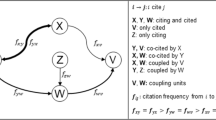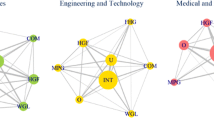Abstract
In recent years, numerous studies have been published which have used bibliometric data to look at collaborations in research. This study presents a proposal with which the topical connections of the institutions of an organization can be investigated through analysis of co-authorships, direct citation links, and co-citations. Based on various bibliometric data sets for an organization whose institutions are used as an example, this study illustrates the possibility of comparing the self-perception of institutions of this organization (co-authorships, direct citation links) with a view to (possible) mutual collaboration with the external perception (co-citations). This comparison is made firstly for the whole organization with the aid of network graphs; secondly, the comparison is presented in a table for a specific institution and its (possible) collaborations in the organization. Particularly the tabular breakdown of the links between the institutions can provide concrete indications of possible further collaboration between the institutions which have not yet manifested themselves in co-authorships.



Similar content being viewed by others
References
Adams, J. (2012). Collaborations: The rise of research networks. Nature, 490(7420), 335–336.
Adams, J. (2013). Collaborations: The fourth age of research. Nature, 497(7451), 557–560. doi:10.1038/497557a.
Börner, K., Sanyal, S., & Vespignani, A. (2007). Network science. Annual Review of Information Science and Technology, 41(1), 537–607. doi:10.1002/aris.2007.1440410119.
Boyack, K. W. (2009). Using detailed maps of science to identify potential collaborations. Scientometrics, 79(1), 27–44. doi:10.1007/s11192-009-0402-6.
Boyack, K. W., & Klavans, R. (2010). Co-citation analysis, bibliographic coupling, and direct citation: Which citation approach represents the research front most accurately? Journal of the American Society for Information Science and Technology, 61(12), 2389–2404.
Bozeman, B., Fay, D., & Slade, C. (2013). Research collaboration in universities and academic entrepreneurship: The-state-of-the-art. The Journal of Technology Transfer, 38(1), 1–67. doi:10.1007/s10961-012-9281-8.
de Nooy, W., Mrvar, A., & Batagelj, V. (2011). Exploratory social network analysis with Pajek. New York, NY, USA: Cambridge University Press.
de Solla Price, D. (1965). Networks of scientific papers: The pattern of bibliographic references indicates the nature of the scientific research front. Science, 149(3683), 510–515.
Eisend, M., & Schmidt, S. (2014). The influence of knowledge-based resources and business scholars’ internationalization strategies on research performance. Research Policy, 43(1), 48–59.
Kamada, T., & Kawai, S. (1989). An algorithm for drawing general undirected graphs. Information Processing Letters, 31(1), 7–15.
Katz, J. S., & Martin, B. R. (1997). What is research collaboration? Research Policy, 26(1), 1–18.
Kumar, S., & Jan, J. (2013). Mapping research collaborations in the business and management field in Malaysia, 1980–2010. Scientometrics, 97(3), 491–517. doi:10.1007/s11192-013-0994-8.
Lancho-Barrantes, B., Guerrero-Bote, V., & Moya-Anegón, F. (2013). Citation increments between collaborating countries. Scientometrics, 94(3), 817–831. doi:10.1007/s11192-012-0797-3.
Martin, T., Ball, B., Karrer, B., & Newman, M. E. J. (2013). Coauthorship and citation patterns in the physical review. Physical Review E, 88(1), 012814.
Mulligan, A., & Mabe, M. (2006). Journal futures: Researcher behaviour at early internet maturity. Paper presented at the UK Serials Group (UKSG) Annual Conference, University of Warwick, UK.
Simonton, D. K. (2013). After Einstein: Scientific genius is extinct. Nature, 493(7434), 602.
Small, H. G. (1977). A co-citation model of a scientific specialty: A longitudinal study of collagen research. Social Studies of Science, 7(2), 139–166. doi:10.1177/030631277700700202.
Smith, R. (1988). Problems with peer review and alternatives. British Medical Journal, 296(6624), 774–777.
Subramanyam, K. (1983). Bibliometric studies of research collaboration: A review. Journal of Information Science, 6(1), 33–38. doi:10.1177/016555158300600105.
van Raan, A. F. J. (2000). On growth, ageing, and fractal differentiation of science. Scientometrics, 47(2), 347–362.
Ziman, J. (2000). Real science. What it is, and what it means. Cambridge, UK: Cambridge University Press.
Acknowledgments
The data used in this paper are from a bibliometrics database developed and maintained by the Max Planck Digital Library (MPDL, Munich) and derived from the Science Citation Index Expanded (SCI-E), Social Sciences Citation Index (SSCI), Arts and Humanities Citation Index (AHCI) prepared by Thomson Reuters.
Author information
Authors and Affiliations
Corresponding author
Rights and permissions
About this article
Cite this article
Bornmann, L., Leydesdorff, L. Topical connections between the institutions within an organisation (institutional co-authorships, direct citation links and co-citations). Scientometrics 102, 455–463 (2015). https://doi.org/10.1007/s11192-014-1425-1
Received:
Published:
Issue Date:
DOI: https://doi.org/10.1007/s11192-014-1425-1




